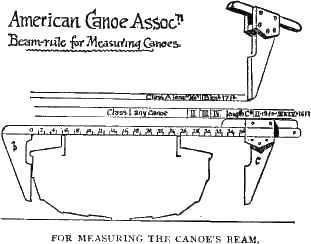
IV. CANOE UNDER SAIL (II).
98 • 99
Getting Under Way.
The board is housed when running free and when the canoe is on shore. It is dropped for windward sailing. It is sometimes left down when running free in a heavy sea to help steady the canoe where the greatest speed is not the prime object, for it does to some extent retard progress, as is easily demonstrated by paddling with a board down. It may be dropped part way to advantage at times, even when paddling to windward, not directly in the wind's eye; it prevents turning and the constant use of the rudder. The board should be so arranged that it can be easily removed when on shore, in order to get at all its parts for cleaning and oiling, and also that the weight of it need not be carried when on a paddling cruise.
A Short Spin. THE canoe is in the water and rigged -- ballast stowed ready for a spin. Jump aboard and shove off! Run up the mizzen, belay the halyard when all is taut, trim in sheet, bringing boom amidship; belay and let the canoe swing round head to the wind. The mizzen will now keep her there, though she may make some sternway; but what matters that? you are well clear of the shore. Look alive, there! is the end of that mizzen sheet made fast below? All right ! Is the slack of the halyard coiled up neatly so it will go with a run and let the mizzen drop into the lazy jacks when cast off, if a squall should happen to come along? Ay, ay, sir! Now hoist the mainsail, having first placed the boom to port, on which side the sail is to fill when you bear away. Look out for your head, there, or the boom may give you a crack as it swings about with the wind on the sail. Put your weight on the halyard, it will bear it, and get that sail snug up, so it will stand out like a board when it gets the wind in it. Belay. Cast off mizzen sheet, shove main boom to windward, let the bow fall off a little. There you are; now she fills. Start her off with a beam wind. See figure on page 101.
Let go the boom and trim the mainsail (No. 1); belay sheet. Trim mizzen to same angle and belay. Get on deck to windward, there, with the left hand on tiller and the main sheet in your right. Now she is just bowling along. Bear away, there; let her have more sheet; yes, mizzen too (No.3), and run down the wind a bit. Here -- what are you doing on deck, there? Down in the hold with you, and feet on the yoke, never mind the tiller; it won't run away. Look out for the jibe, for if that boom ever comes over with you in the bottom, you are a goner. Must jibe soon? Well, get that mizzen over first (No. 4). Haul in on the sheet and put the boom over with your hand, if it will not go over of itself. Now look out for the mainsail. Up on deck
100 • 101
Canoe Handling.
with you, amidship, though; give a touch to the tiller; haul in that main sheet. Look out! there she comes; let her go ! and as the boom brings up all standing to starboard, see that you are on deck to port. Trim in main sheet (No. 6) and bring the wind on the beam again (No.7). Trim in mizzen for close-hauled work, as you must go on the wind in a few seconds to get back home again. Luff her up a little and trim in mainsail flat. That will do (No. 8); any closer would put a shake along the luff. Keep her there; luff just full, no more. Look under the main boom to see ahead. Pretty near shore, are you? Well, come about.The helm is the steering apparatus, usually applied to the tiller. Starboard the helm means to move the tiller to starboard, and this carries the canoe's head to port -- steers her to port. To port the helm carries the head to starboard -- steers to starboard when the canoe has headway. To put the helm hard down means to put the tiller around to leeward, steering the canoe up into the wind. Hard-a-lee and hard down mean the same thing -- moving the tiller to leeward as far as it should go, thus bringing the canoe's head to windward as quickly as possible. Hard up means moving the tiller as far to windward as possible, and results in turning the canoe off the wind quickly -- bearing away. When the canoe has sternway on -- moving backward -- turning the tiller to starboard brings the bow around to starboard and carries the stern to port. A weather helm means that when the canoe is sailing on the wind she has a tendency, by the disposition of her sail area, to luff when the rudder is let alone.

102 • 103
Coming About.
With a lee helm she falls off unless the rudder is used. When the canoe just balances -- keeps her true course without the aid of the rudder -- she is said to carry an even helm. A slight weather helm is to be sought after in arranging the disposition of the sail area. A lee helm is to be very carefully avoided. The sail is too far forward when the canoe has a lee helm It is too far aft with a strong weather helm. Shift the sail on the mast all you can to get an even balance or a slight weather helm if you find the canoe does not balance on trial. (See Appendix, balance of sail.)If you cannot shift the sail enough on the mast to accomplish the desired result, then have the mast tube and step shifted. The true balance can be very closely calculated beforehand, as fully explained in "Canoe Building for Amateurs."
If you have not run hard and fast aground by this time, we will at once come about. Helm hard-a-lee, there ! Let go the main sheet. Do not jam the tiller around too far, nor too quickly, either, thus stopping headway, but do all gently and comfortably. Don't touch that mizzen sheet; the sail helps to bring the canoe head to the wind. When she gets there, let go the mizzen sheet; and as she falls off on the other tack, trim in mainsail flat, again taking the true course, now you can trim in mizzen. A heavily ballasted canoe has enough momentum to bring her round without letting go the mizzen, that is, unless in very rough water. If you find the canoe loses headway quickly for want of ballast, get your own weight well forward as you come about, and it will help to bring her around greatly. If she hangs in stays, shove the mainsail over to get the bow around just as she is in the wind's eye -- mizzen of course cast off. If this does not work, but results in sternway, shove the tiller clear over to the opposite side. If this fails and she falls off on the same tack, let her go, get headway on, and when at full speed again try once more to get her about. Jibing is dangerous but easy. Coming about is perfectly safe, as the wind is entirely out of the sail, but difficult. Therefore try it often and acquire the knack of knowing just how to do it, and, what your particular canoe needs to accomplish it every time. The paddle should never be used, as it is not allowed in racing under the rules; it is very unseamanlike to resort to it, and if used, will tend to satisfy you with only half learning how to manage the canoe under sail. We are off again, on the starboard tack this time (No. 11), having been on the port tack before (No. 8). Come about well off shore (No. 12), so if you don't get around the first time you will have plenty of sea room to try it again. As you approach the home float (No. 14), steer a little below it, to leeward of it, and luff up into the wind just as you get in line with it, allowing the canoe to run up to windward till all headway is lost before coming up alongside. Novices frequently try conclusions with a float, the shore, or a wharf, by sailing right at them, becoming nervous and not knowing how to stop before going smash
104 • 105
Reefing.
into them at full speed. This does not always result seriously to the float, but it is apt to damage the canoe. If you do not feel sure of making a good landing, luff up a little off shore, drop the mainsail and paddle in, or sail in under mizzen alone. No damage will then result to nerves, canoe or float. Making a neat landing is a thing of beauty and a joy forever. Do not lose the chance of relishing it by neglecting practice.It is much more difficult to tack in a heavy sea than on calm water. Learn to do it, therefore, on smooth water first, and in a light wind. With a stiff breeze and lumpy water, if you can't get the canoe to tack, paddle round rather than wearing away and getting on the other tack after a jibe. It is well to lower the mainsail if you have to jibe on very rough water in a stiff breeze.
When beating to windward, depend on the sail alone for information as to the course you should take. Keep it just full and sail so close that by luffing a little now and then the consequent shiver on the luff of the sail will tell you exactly where the wind is. Sailing any way but close-hauled, you must lay your course and trim the sail to get the best speed out of the canoe. When the wind is abeam or forward of the beam, let out the sail till it begins to shiver, and then trim in so it is just full. Wind abaft the beam, trim sail as before explained, shifting it at first a little perhaps one way, and then the other, to hit the highest speed point. Don't depend on any fly at mast head to trim sail by, but learn to trim it by itself alone, knowing, of course the exact direction of the wind.
Shifting ballast is at times a good thing, and convenient if you sit in the well all the time. Twenty five pounds of shot up to windward on the bottom board does counteract some wind pressure on the sail; but if you forget to shift it when you come about, rest assured it will not do you any good way down to leeward out of reach. If your ballast is all on the very bottom, and so fastened that it cannot shift, no matter how much the canoe heels, you have, one less item of worry to think of. You can depend on its all being there, too, when it is needed.
Place all the ballast as near amidships as possible, if it does not spoil the trim, so the ends of the canoe will be light and she will ride the waves easily and lightly. A canoe may be made to trim perfectly with the ballast spread out nine or ten feet along the keel, and she will sail well on smooth water; but on rough water she will plunge heavily and ship the seas easily, every now and then burying the bow and much of the forward deck. Spreading out the ballast makes a canoe logy, if such an expression be permitted.
Reefing. THE amount of sail that can be carried on a canoe depends on the force of the wind -- on its speed, really. It is not practicable to have a number of sails of different sizes to suit every breeze that blows. A sail should be used part of the area of which can be disposed of so as not to present wind surface when less sail is made necessary by more wind.
106 • 107
Reefing Gear.
Practically, all canoe sails, therefore, are capable of being reeled, that is, partially taken in. A reef is that part of the sail which can be tied in with lines called reef points, on both sides of the sail. These lines are placed a foot or more apart and an equal distance above the boom. When a reef is to be taken in the sail is lowered till the reef points come even with the boom, around which they are tied, gathering the cloth in compactly along the boom. The mainsail is generally made with from one to three reefs. The mizzen has from one to two. It is well to have the mainmast tube and mizzenmast tube of the same size, so the mizzen can be stepped forward, a storm mizzen placed aft, and the mainsail dispensed with altogether in a heavy blow.Suppose you have a lug mainsail of 75 feet area, a mizzen of 25 feet area, and a storm leg of mutton laced to its mast of 7 feet. The wind is light and you carry full sail, mainsail, mizzen, together 100 feet. The wind increases and you reef the mizzen (10 ft.), leaving 90 feet up. More wind, and a reef is taken in the mainsail (20 ft.), leaving 70 feet up; the general balance varying very little with these changes. It comes on to blow, and you drop the mizzen (15 ft.) into the lazy jacks and pass a line over it so the wind cannot blow it about. You now have but one sail up, the mainsail reefed once, giving 55 feet wind surface. But it blows harder, and you must reduce still more. Take in a second reef (20 ft.), leaving up but 35 feet for the wind to act on.
The blow turns out to be a small gale. Take down the mainsail and mast, lash them on deck securely, set the mizzen forward, full sail up (25 ft.), or put one reef in it and set the storm dandy (7 ft.) aft, thus spreading 22 feet, and you are in good shape to weather a pretty heavy blow. If this is found to be too much sail for a howling gale that you happen to be caught out in, stow the mizzen below and place the storm dandy forward; now scud down the wind and get into the first harbor you can find -- it is no canoe weather to be out in.
This reefing business is a serious affair and has, one way and another, in thought, occupied many an hour's time of probably every canoeist that ever did any sailing. When it becomes necessary to reef, you want to reef quickly, in order that the control of the canoe may not be lost. When a yachts sail is to be reefed, she is luffed up to bring the sail inboard and to spill the wind out of it. The sail is lowered the proper distance, and as many of the crew as possible tie down the points. When all is snug the sail is hoisted up all taut again and the yacht allowed to fall off to her true course.
To reef a canoe sail, having the ordinary reef points as shown in Fig. A, on page 109, the canoeist must leave the tiller, crawl clear out on deck to reach the forward points of his sail to tie them in; and in doing this the canoe is bound to luff up into the wind, his weight being forward, to lose all headway, become partially unmanageable, and she is pretty sure to roll about considerably if there is any sea on, thus retarding the work of reefing greatly. In some canoes it is almost impossible to reach the tack end of the boom on account of the mast being stepped far forward to preserve the balance of sail area. Some other reefing arrangement is therefore necessary in such cases.
108 • 109
Canoe Handling.
Figure B shows an arrangement by which the sail is reefed from the well by means of a line, the end of which is at the clew end of the boom. The sail is lowered till the batten is down on the boom, the line is then pulled in as far as it will come, and the slack wound around the batten and boom together where they project beyond the cloth of the sail at the clew. The sail is hoisted taut and halyard belayed.This reefing line has one end made fast at the forward end of the boom; it leads from there (through a ring sewed into the sail half way between boom and batten) through a block attached to the under side of batten at the luff, from here along batten across sail and through a block on middle of batten, down to boom -- through a ring on sail half way between boom and batten, as on luff -- through a block on boom and diagonally across sail through a block on batten at the leach end, leaving a few inches of slack beyond the block when the sail is up. At this end is a short stick, or button, as it is called, around the middle of which the line is wound in a groove to prevent slipping, and the end whipped. This button prevents the line end running back through the block. By pulling in this line when the sail is lowered batten to boom, the reef is taken in and the batten and cloth below it are held more or less neatly along the boom.
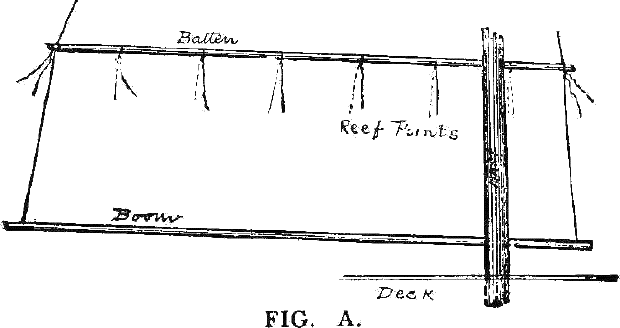
110 • 111
Baden-Powell Reefing Gear.
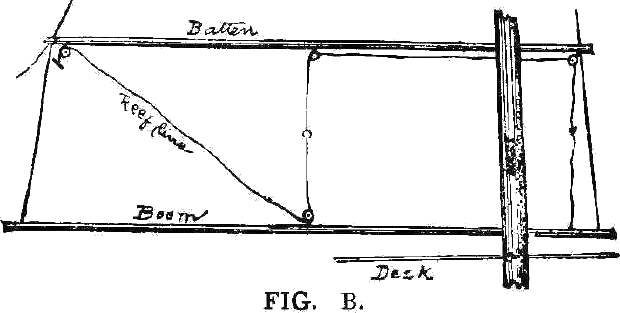
Even with reef points a line from batten to nock at tack on boom and leading along boom to the clew end enables the skipper to get the forward part of his reef in without getting clear out on deck, The balance of the points can then be easily reached and tied in. This Fig. B reef has one weak point. The cloth is not closely tied in along boom and catches the wind; the boom has to be brought amidship in order to reach the reefing line, and this is a difficult position to keep it in with a stiff breeze blowing and the canoe apt to fall off from the wind at any moment. The disadvantages of these two reefing gears, A and B, are not very serious with small sails, say from thirty to fifty feet in area.With larger sails they are clumsy and very imperfect, slow in being tied or taken in, and difficult to shake out quickly when more sail could be used to advantage. Many other gears and arrangements have been tried a number of which are now in use, two of them are illustrated on page 109, Figures C and D.
C is the gear invented by Mr. Baden-Powell and now in use on many English and some American canoes. D is a gear largely used in this country for the larger balance lug sails and, slightly modified, on the Mohican settee and the Stoddard sail. It can only be applied to the first reef. C can be arranged for three reefs.
Nautilus Reefing Gear.
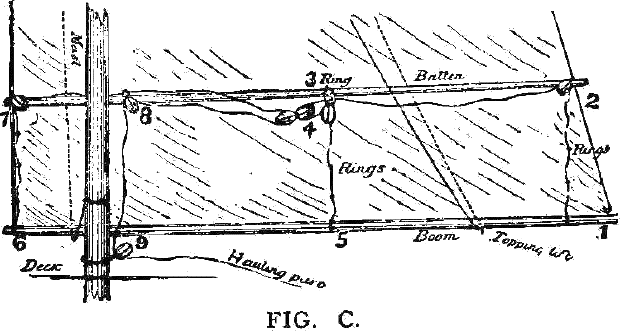
A LINE is made fast to boom at clew end (Figure C, page 109, at point marked 1); it is run up to the batten, passing through small brass rings sewed on a tape along leach, two or three inches apart; at the batten it runs through a block (2) and then leads to a loop over the block (3) at the middle of the batten; passing through this loop -- which is used only as a guide -- it runs through one of the halves of a sister block (4) (two blocks lashed head to head, or a single block with two sheaves, one at each end, and not alongside each other as in a double block), back through the block under the loop on batten (3) and through rings again down to boom at (5), where it is made fast permanently. Another line starts at (6) the tack end of boom, to which its end is secured; leading through rings on the luff up to a block on the batten (7) through which it passes, leading along the batten through a guide loop over block (8) on batten just aft of the mast, out to the sister block, through which it leads, returning to block on batten (8), through it, down to block at foot of mast (9) and along deck to within easy reach of skipper's hand.The reef line when hauled in, the sail being dropped sufficiently, pulls directly on the boom at the tack, taking in the reef there, and indirectly by means of the sister block in the bight of the line running from 1 to 5, brings the boom up to the batten at these points, gathering the sail in neatly along boom, the rings keeping the cloth in close. Exactly the same method is employed for a second, and a third reef. The reef gear in this arrangement is entirely on one side of the sail. With this arrangement a jackstay must be used to keep the boom in position when the halyard is cast off to lower the sail.
If you like the Baden-Powell reef and put it on your sails, be careful to arrange the spacing so that 8 is a little more than the exact distance between batten and boom from the block at (3); for, in taking in the reef, the sister block (4) moves from 3 toward 8 the distance between 1 and 2 increased by the stretch of the lines.
112 • 113
Dot Reefing Gear
When the lines are wet they are much shorter than when dry. This gear can be worked with the sail in any position, and does not require the skipper to get boom inboard, and consequently luff the canoe, to work it. In fact, the reef can be turned in when the canoe is sailing before the wind with the boom clear out at right angles to the keel, and without losing headway at any time.This is a great advantage over the slow and clumsy tying in of the reef points, especially in racing, when every minute's headway lost counts. The blocks used are of English make, and are of boxwood with brass sheaves neatly put in. These blocks can now be had in this country, some of the dealers having imported them. The best cordage, too, for canoe lines is of English make, but it also is now imported.
The Dot Reef.
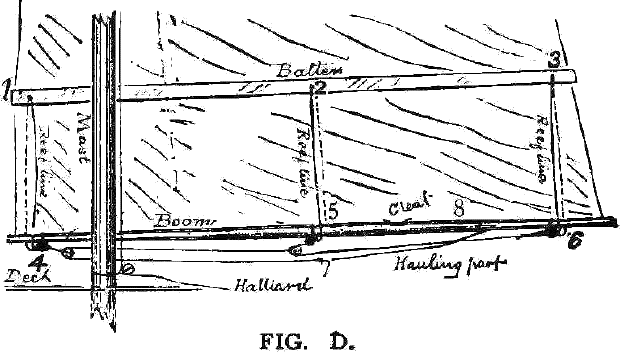
THREE holes are made through the cloth and batten at points 1, 2, 3, Figure D. If the batten is light and a hole would weaken it, a cringle just above the batten through the cloth will do as well. At 4, 5, 6 on boom-directly under 1, 2, 3 on batten -- thimbles are lashed securely on the under side of the boom, having the hole through them running in the direction of the length of the boom. A thimble is a small cylinder of hard wood having a groove around it so a cord run round in the groove will not slip. Instead of a thimble two blocks can be used, one on each side of the boom. Sometimes the boom is made to serve the purpose of one side of the block, the ends of the block being screwed to it and the pin run through the block and sheave and into the boom for its support at one end.This is the arrangement used by Mr. Stoddard on his canoe Atlantis. A line is led through the thimble 4, passes up from the boom on the left side of the sail to the batten, through the cringle to the right side of the sail, down the sail again to the boom and back through the same thimble. The line coming down on each side of the sail as it does, passes double through the thimble, entering its forward end and coming out pointing aft. Both lines are cut about four inches from the thimble and made fast round a block-if block is of wood-or through the eye of the block if of brass.
Similar double lines are placed between 2 and 5, 3 and 6; or, more correctly speaking, a line is run through thimble at 6 -- entering its forward end-carried up the left side of the same to 3, through the cringle and down the right side of the sail and back through the thimble. Its end is then lashed securely at this point, forming a loop which includes within it the batten at 3, the boom at 6 and the cloth of the sail between 3 and 6. This line continues along the boom to the forward end of the thimble at 5. It is left a little slack between 5 and 6.
114 • 115
Carrying Sail.
Before entering the thimble it is run through a block (7) which is left free to play along it. Passing through the thimble from fore and aft, it runs up the sail to cringle at 2, through it and down the other side of the sail to aft end of thimble, through it, and about two inches beyond. It is here cut off and the end securely lashed to the main part of the line as before. Thus another loop is formed about batten, boom and cloth between 2 and 5. A line secured to block 7 runs forward and through the block on the reef line at 4; from here it runs clear of everything out to point 8 on boom, where its end is made fast. A cleat is lashed to the boom at 8 by which the reef line is secured when the reef is taken in. Now dropping the sail and hauling in on the reef line at 8 brings batten and boom together, and the loops gather the cloth in as well, thus forming a neat and compact reef. The advantage of having the reef line end on the boom is that the reefing gear then in all its parts is entirely on the sail and is not interfered with when the sail is taken off the mast. The objection to it is that the boom has to be brought close enough to the skipper in reefing to allow him to reach the line and cleat at 8, thus necessitating some slight change in the canoe's course. The reef can be turned in or shaken out in thirty seconds, as can also the Baden-Powell. 4 and 5 must be twice the width of the reef apart to allow room to take in all the slack. By shifting this rig end for end, j and 4 where 3 and 6 now are, and adding a, block on boom by the mast and one at the foot of the mast, the reef line can be carried down to and along deck in exactly the same way as the Baden-Powell reef line runs.With a very wide reef it is well to sew on rings through which the lines may pass on both sides of the sail and half way between the points 1 and 4, 2 and 5, 3 and 6. A closer gather of the cloth thus results. This reef is used on the Mohican settee, with plain rings substituted for the thimbles. The second reef is usually arranged with the ordinary reef points and reef line for luff end. This reef is a simpler one to make and fit than the Baden-Powell, and makes a closer reef along the boom, not bunching the cloth up so much.
The reefing line from the mizzen must come at least as far forward as the tack end of the boom to be within reach when the skipper is sitting on the after cockpit hatch. With the Dot gear two reef points are all that need be used on the mizzen. Three are required for the mainsail. The mizzen reef line should be so arranged that it can be operated at tack end of boom when the sail is used as a mizzen, and at the clew end when the sail is stepped forward and used as a mainsail. This can easily be managed by having it work from a block in the middle of the boom, and lead from this, as the case may be, either forward or aft.
Carrying Sail. ALWAYS keep your sail area down to a spread that can be easily and safely carried. By reefing you are enabled to do this. A little too much sail needs constant care and watching, perpetual luffing during the puffs, and heels the canoe over way beyond her best sailing position.
116 • 117
To Rig and Bend Sails.
Therefore proportion the sail to the wind, that you may keep your course all the time and sail steadily. What you lose on your mate, who has too much sail spread, during the lulls, you will gain on him when the puffs come and you can keep full headway on, he having to continually luff and spill the wind out of his sail to keep right side up, thus losing way all the time. Be comfortable and avoid running great risks. You may lose a race now and then, but you will often win, and at the finish be over the line long before the leader during the first half of the race gets his canoe right side up and the water out of her.If you ever get caught in a thunder squall, and cannot make a harbor, get in all sail, stow as much below deck as possible, take down the masts, and securely lash masts and sails on deck so they present as little wind surface as possible. Leave no loose end of the sail for the wind to get under, perhaps to raise up and capsize the canoe. Depend on paddle alone, and keep the bow headed into the teeth of the wind, even if you are making sternway. Squalls of any kind usually give warning of their approach, if they are severe enough to do harm. Learn to read the signs of nature, and get in the sail or make a harbor before you get caught in a tight place. Don't attempt to carry sail till the last moment; it may then be too late to even get it in. Acquire judgment, if you are lacking, by constant study.
Monkeying. THIS is a word which has come into general use contemporaneously with the canoe. Whether it owes its origin to the canoeist perhaps will never be known. It is a fact, though, that a few years ago, when canoe builders were few and they confined their labors to the canoe alone, the canoeist found, after he had purchased his boat, that only half the battle was won. He needed a seat, steering gear, sails, blocks, cleats, running rigging; and he needed them in such shape, too, that they would fulfill his desires and serve his wants. This work he could get no one to do for him, so he set to work to do it himself. As he had never done anything of the kind before, the first trial failed; the second was a partial success, perhaps, but opened up enormous possibilities; and thus he was led on from one thing to another till he found much time taken from other important occupations, and yet he was far from satisfied with the results of his labors. It began to be said of him, when other things came up for him to do, "Oh, Jack is out of the question; he can't come, you know; he is monkeying with that canoe's fan mainsail." There are still many little touches about 'a canoe that cannot be bought; and where is there a builder who can rig a canoe one-half as well as some of the canoeists themselves? Therefore, if you want peace of mind, monkey. Learn the different useful knots; square knot, bowline, half-hitches, etc., and induce some old tar to show you how to whip a rope's end, to splice, to do lashings neatly, and
118 • 119
Monkeying
many other sailor dodges more or less useful. Rig your own sail, bend it to the boom and yard, attach the halyards and sheets just where they should be to work to the best advantage; adjust the parrels, screw down the cleats, place the steering lines and construct your reefing gear. Thus will you learn much, become bandy with lines, the palm and sail needle, and so be able to do better and stronger work about the sailing gear than any builder in the country, whose business it is to construct canoes, and not to sail them. Probably no two canoes in the country are rigged exactly alike, and this shows conclusively that the canoeists must be a monkeying set of fellows, for originality is a rare quality among men in most walks of life. Attending an ACA meet will give you a good idea of the originality that has been displayed by canoeists, and it will no doubt suggest many ideas for improvement to you, though you may be a recent recruit.Know your gear and watch it. Supply new parts as soon as any weakness displays itself in any part. Accidents don't often happen to the careful and painstaking canoeist. It is the careless man who loses a race just at the finish by the parting of a rudder line or sheet.
Keep the sails dry. If they get wet, let them dry spread out, and sun them, if possible, before rolling them up to stow away. Oil, Vaseline and grease are good things to prevent friction and consequent wear. They are cheap, too. Put all your things in or near the canoe when you bring her into the house after an outing. You can thus easily find them again when wanted, and they are less apt to be damaged than if left anywhere, scattered about. Varnish is cheap, too; therefore have the wood of the canoe well protected by it at all times. If you can't varnish the canoe yourself, learn to do it, or get some one who can. Don't neglect this.
© 2000 Craig O'Donnell
May not be reproduced without my permission.
